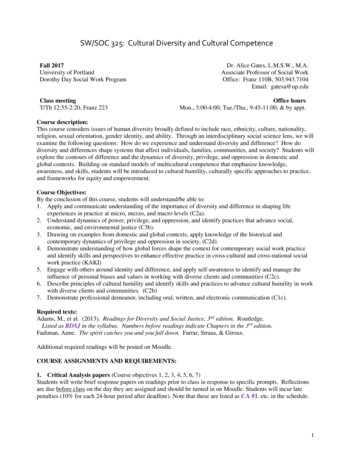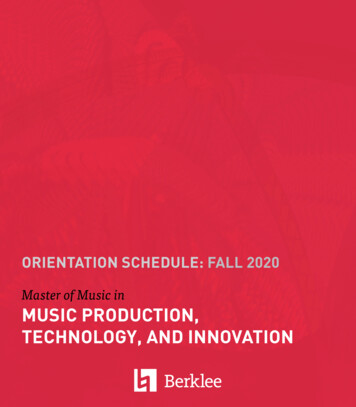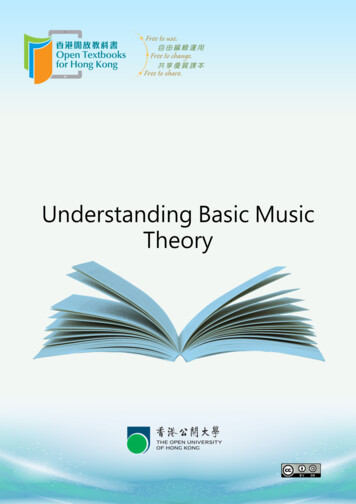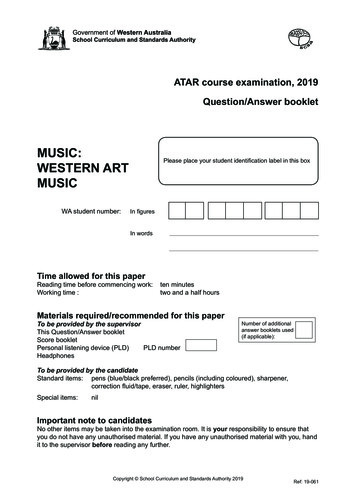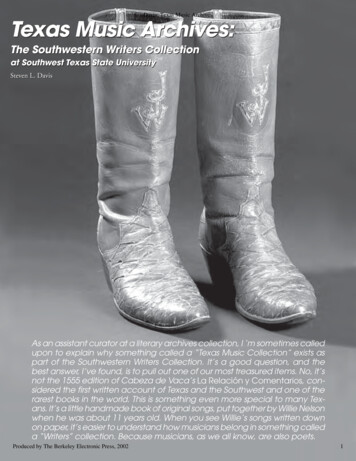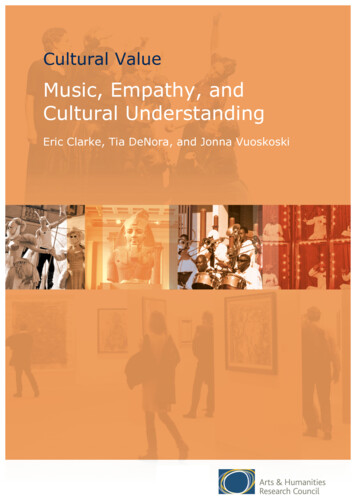
Transcription
Cultural ValueMusic, Empathy, andCultural UnderstandingEric Clarke, Tia DeNora, and Jonna Vuoskoski1
MUSIC, EMPATHY, AND CULTURAL UNDERSTANDINGMusic, Empathy, and CulturalUnderstandingEric Clarke, Tia DeNora, and Jonna VuoskoskiExecutive SummaryIn the age of the internet and with the dramatic proliferation of mobile listeningtechnologies, music has unprecedented global distribution and embeddedness inpeople’s lives. It is a source of intense experiences of both the most individual (personalstereos) and massively communal (large-scale live events, and global simulcasts) kind;and it increasingly brings together or exploits a huge range of cultures and histories,through developments in world music, sampling, the re-issue of historical recordings,and the explosion of informal and ‘bedroom’ music-making that circulates via YouTube.For many people, involvement with music can be among the most powerful andpotentially transforming experiences in their lives. To what extent do thesedevelopments in music’s mediated and mediating presence facilitate contact andunderstanding, or perhaps division and distrust, between people? This project haspursued the idea that music affords insights into other consciousnesses andsubjectivities, and that in doing so may have important potential for culturalunderstanding. The project: 1) brings together and critically reviews a considerablebody of research and scholarship, across disciplines ranging from the neuroscience andpsychology of music to the sociology and anthropology of music, and culturalmusicology, that has proposed or presented evidence for music’s power to promoteempathy and social/cultural understanding through powerful affective, cognitive andsocial factors, and to explore ways in which to connect and make sense of this disparateevidence (and counter-evidence); 2) reports the outcome of an empirical study thattests one aspect of those claims – demonstrating that ‘passive’ listening to the music ofan unfamiliar culture can significantly change the cultural attitudes of listeners with highdispositional empathy.Researchers and Project PartnersEric Clarke, Faculty of Music, University of OxfordTia DeNora, Sociology, Philosophy & Anthropology, Exeter UniversityJonna Vuoskoski, Faculty of Music, University of OxfordKey wordsMusic, Empathy, Cultural Understanding, Sympathy, Attunement, Intersubjectivity,Alterity2
MUSIC, EMPATHY, AND CULTURAL UNDERSTANDING1. IntroductionMusic is a source of intense experiences of both the most individual (personal stereos,headphone listening) and massively communal (large-scale live events, and globalsimulcasts) kind; and it increasingly brings together – or exploits – an exceptional rangeof cultures and histories, through developments in ‘world music’, sampling, historicalrecording and hybridization. At a time when musicology, the social and cultural study ofmusic, have become far more circumspect about essentializing and romanticizing claims,it is still not uncommon to find claims being made for music as a ‘universal language’that can overcome (or even transcend) cultural difference, break down barriers ofethnicity, age, social class, ability/disability, and physical and psychological wellbeing.There are widespread symptoms of this belief or claim, including the activities of theWest-Eastern Divan Orchestra (founded by Edward Said and Daniel Barenboim, to bringtogether Israeli and Palestinian musicians);1 and the appointment by UNICEF of classicalmusicians to act as ‘goodwill ambassadors’, bringing their music to people in deprived,war-torn, or disaster-hit parts of the world so as to offer emotional support, solidarity,and a kind of communion. An extract from the violinist Maxim Vengerov, who in 1997was the first classical musician to be appointed a goodwill ambassador, reads: “1997,September: For Maxim Vengerov’s first official undertaking with UNICEF, he organized amusical exchange with children from Opus 118 – a violin group from East Harlem, NewYork. The children of Opus 118, aged 6 to 13, came from three different elementaryschools in this inner-city neighbourhood. This innovative programme has spurred awhole generation to learn ‘violin culture’. Along with the youths, Mr. Vengerov not onlyplayed Bach but also southern blues and tunes such as ‘Summertime’ and ‘We ShallOvercome’.” And from the same webpage(http://www.unicef.org/people/people 47229.html), beneath a picture showing theviolinist in jeans and T-shirt playing as he leads a line of children in the manner of alatter-day Pied Piper is the caption: “In the remote village of Baan Nong Mon Tha,children from the Karen hill tribe ethnic group follow Maxim Vengerov, in a human chain,to a school run by a UNICEF-assisted NGO. Thailand, 2000.” Similarly, the 1985 Live Aid,and 2005 Live 8, events were global pop music events intended not only to raise money(in the case of Live Aid) and popular pressure on politicians (in the case of Live 8) for therelief of famine and poverty, but also to galvanize a global consciousness and a united‘voice’: as Bob Geldof, the prime mover of Live 8 put it: “These concerts are the startpoint for The Long Walk To Justice, the one way we can all make our voices heard inunison.” And finally, the popular UK television series ‘The Choir’ (which has run to sixseries so far) documents the powerful ‘identity work’ and intense emotional experiencesthat accompany the formation of choirs in schools, workplaces, and militaryestablishments out of groups of people who have had little or no previous formal musicalexperience, and who come from very varied walks of life (from bank executives to fireofficers and military wives).In all these very public examples of a much wider if less visible phenomenon, wesee a complex mixture of implicit musical values, discourses about music’s ‘powers’, folkpsychology and its sociological equivalent, and (in some cases) more or less grounded orunsupported claims about the impact of music on the brain (cf. Tame, 1984; Levitin,3
MUSIC, EMPATHY, AND CULTURAL UNDERSTANDING2006). It would be easy to be hastily dismissive of some of these claims, but aconsiderable volume of research by highly-regarded scientists and scholars, coming fromdisciplines that range from neuroscience and philosophy through psychology andsociology to anthropology and cultural studies has also made a significant case for thecapacity of music and musicking (Small, 1998) to effect personal and social change (e.g.Becker 2004; DeNora 2013; Gabrielsson 2011; Herbert 2011). If music can effectchange, and speak across barriers, it can also offer a means of interculturalunderstanding and identity work. As Cook (1998: 129) puts it:“If both music and musicology are ways of creating meaning rather than just ofrepresenting it, then we can see music as a means of gaining insight into thecultural or historical other If music can communicate across gender differences,it can do so across other barriers as well. One example is music therapy But themost obvious example is the way we listen to the music of other cultures (or,perhaps even more significantly, the music of subcultures within our own broaderculture). We do this not just for the good sounds, though there is that, but inorder to gain some insight into those (sub)cultures. And if we use music as ameans of insight into other cultures, then equally we can see it as a means ofnegotiating cultural identity.”In different ways, these (and other) claims seem to make use of a generalized notion ofempathy. Empathy has recently seemed to gain considerable attention/currency inmusicology, psychology of music, sociology of music and ethnomusicology as a way toconceptualize a whole range of affiliative, identity-forming, and ‘self-fashioning’capacities in relation to music. But what is brought together or meant by the term‘empathy’, and is it a useful and coherent way to think about music in relation to itsindividual and social effects?Our project, and this report, arise from the disparate nature of the evidence for theclaims about music’s transformative power, individually and socially, and the ‘scattering’of the case across theories and findings in a huge disciplinary range: from research onmusic and mirror neurons (Overy and Molnar-Szakacs 2009) to the ethnomusicology ofaffect (Stokes 2010), the history of musical subjectivity (Butt 2010) and sociologicalstudies of music and collective action (Eyerman and Jamieson 1998), the case has beenmade for different perspectives on music’s capacity to afford compassionate andempathetic insight and affiliation, and its consequent power to change social behaviour.These diverse research strands all point to the crucial role that musicking plays inpeople’s lives, to its transformational capacity, and to the insights that it can afford.There is no single window onto ‘what it is like to be human’, but musicking seems tooffer as rich, diverse, and globally distributed a perspective as any – and one thatengages people in a vast array of experiences located along dimensions of public andprivate, solitary and social, frenzied and reflective, technological and bodily, conceptualand immediate, calculated and improvised, instantaneous and timeless. The fact thatmusic can be heard and experienced by large numbers of people simultaneously and insynchrony (orchestral concerts, stadium gigs, live simulcasts) means that the embodiedexperience of music can also be shared – fostering entrainment and a sense of cosubjectivity. Indeed, some theories of the evolutionary significance of music highlight the4
MUSIC, EMPATHY, AND CULTURAL UNDERSTANDINGimportance of music’s empathy-promoting aspects, suggesting that a fundamentaladaptive characteristic of music is its capacity to promote group cohesion and affiliation(Cross & Morley, 2008).While a whole range of studies has suggested that empathic interaction with otherhuman beings is facilitated by musical engagement, the direct empirical evidence for thisimportant possibility is scattered and disciplinarily disconnected. The aim of the projectsummarised in this report was to examine critically a substantial body of researchevidence that relates to claims for music’s capacity to engender cultural understanding,primarily through the mediating construct of empathy; examine its consequences andsignificance, and provide a framework within which to connect its disparate elements andhighlight points of interdisciplinary convergence and divergence; and carry out a focusedempirical study that was designed to investigate a specific aspect of that complex case.The report follows the general disciplinary outlines of the initial literature search, whichrevealed in excess of 300 items relating to the broad theme (‘Music, Empathy andCultural Understanding’) of the project.2. EmpathyThe word empathy has had currency in English for little more than 100 years, listed bythe Oxford English Dictionary as being first used by the psychologist Edward Titchener in1909, and defined by the OED as:“a. Psychol. and Aesthetics. The quality or power of projecting one's personalityinto or mentally identifying oneself with an object of contemplation, and so fullyunderstanding or appreciating it.b. orig. Psychol. The ability to understand and appreciate another person'sfeelings, experience, etc.”Titchener’s ‘empathy’ was his attempt to translate the term Einfühlung coined by thephilosopher Robert Vischer (1873) in a book on visual aesthetics. But it was TheodorLipps (1903) who really championed the concept of empathy, developing it from anessentially aesthetic category (the ability to ‘feel into’ an artwork) into a much moregeneral psychological/philosophical concept to account for the human capacity torecognize one another as having minds. Laurence (2007) gives an important account ofthe origin and development of the idea of empathy, tracing a line back to Adam Smith’s(1759) The Theory of Moral Sentiments, and Smith’s appeal to a notion of sympathy and‘fellow feeling’ as the basis for understanding and living a moral life that is based onimagining how we would feel in the circumstances of others. The distinction betweenimagining how we would feel and simply identifying with how another feels is crucial,since it places Smith’s notion of sympathy in the domain of imaginative reason ratherthan blind contagion, and makes clear the role of cultural artefacts (paintings, literature,drama, music) as a means of socially learning that sympathetic attitude. Laurence alsodraws significantly on the work of Edith Stein (1917) – a doctoral student of EdmundHusserl – whose On the Problem of Empathy also engages with the problem of how it isthat we can know or experience the mental states of others, whether this knowledge or5
MUSIC, EMPATHY, AND CULTURAL UNDERSTANDINGexperience is given in some direct and primordial sense, and Stein’s conclusion thatempathy is dependent on the mediating role of similarity with the person (or evenanimal) with whom/which we attempt to empathize. Laurence ends up with definition ofempathy that emphasizes empathy as both a process, and as a social and educableachievement:“In empathizing, we, while retaining fully the sense of our own distinctconsciousness, enter actively and imaginatively into others’ inner states tounderstand how they experience their world and how they are feeling, reachingout to what we perceive as similar while accepting difference, and experiencingupon reflection our own resulting feelings, appropriate to our own situation asempathic observer, which may be virtually the same feelings or different butsympathetic to theirs, within a context in which we care to respect andacknowledge their human dignity and our shared humanity.” (Laurence 2007: 24)Finally, and in significant contrast to Laurence, Baron-Cohen (2011) provides a wideranging account of empathy that explicitly presents it as a psychometrically measurabletrait,2 with a genetic and environmental basis, dist
music can be heard and experienced by large numbers of people simultaneously and in synchrony (orchestral concerts, stadium gigs, live simulcasts) means that the embodied experience of music can also be shared – fostering entrainment and a sense of co-subjectivity. Indeed, some theories of the evolutionary significance of music highlight the . MUSIC, EMPATHY, AND CULTURAL UNDERSTANDING
